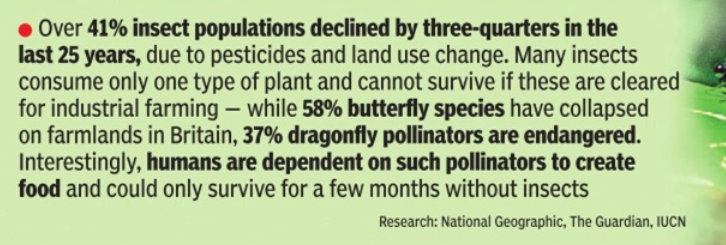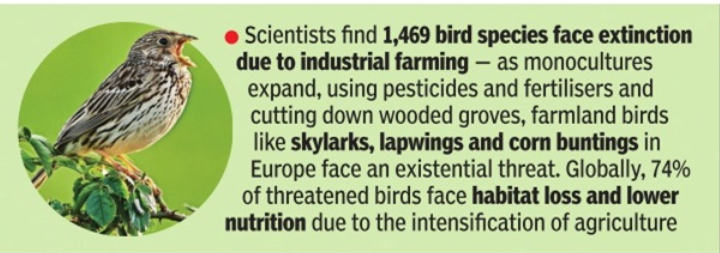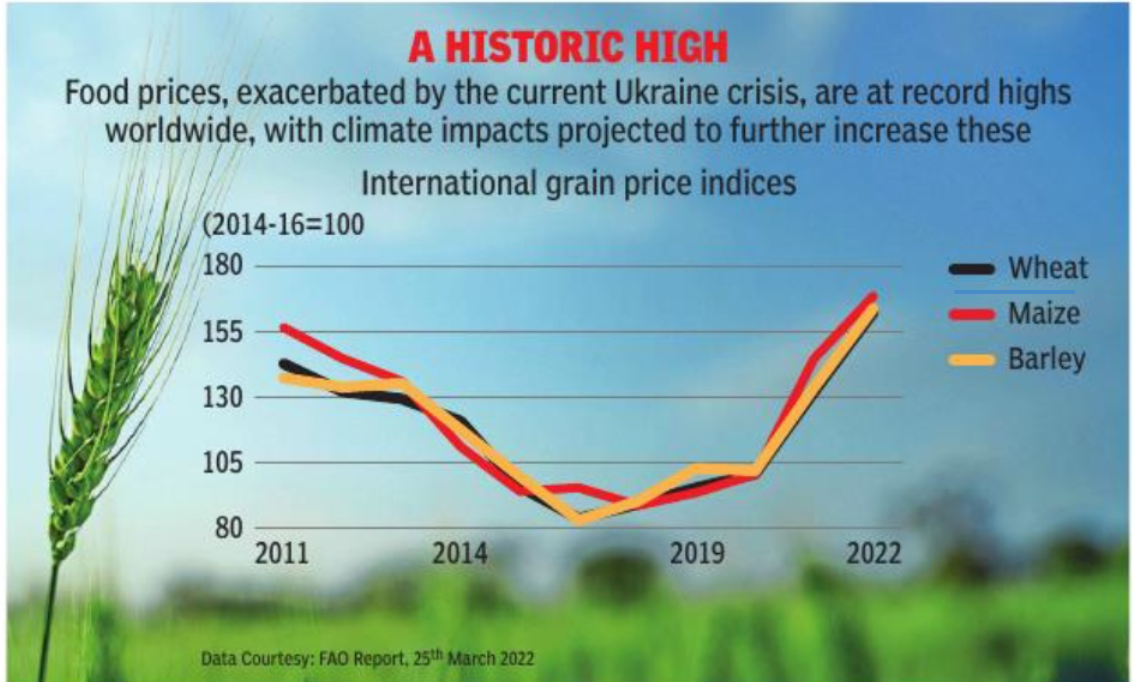ForumIAS announcing GS Foundation Program for UPSC CSE 2025-26 from 19 April. Click Here for more information.
Contents
| For 7PM Editorial Archives click HERE → |
Introduction
The FAO’s latest data show that food prices are at a historical high. Globally, the average food prices in 2021 were the highest in 46 years. Part of the price rise can be attributed to geopolitical reasons, but a great deal is due to the impact of climate change on food systems. Food production faces significant challenges from rising temperatures. Food production and prices have grown increasingly volatile in recent times. Extreme events of climate change have major impacts on food productivity, supply and prices. To avert this, the world needs to develop adaptations that can protect both farmers and consumers.
What are the impacts of climate change on food systems?

Drop-in yields: Traditional staples, like rice and wheat, are witnessing a drop in yields as temperatures increase.
Narrowing food basket: Climate change will also impact the productivity of perishable products. Hence, the overall diversity of the food system will be affected. The food basket might get narrower. Crops like vegetables won’t be able to sustain themselves without more irrigation, which will then affect water supplies.

Increase in droughts and floods: Climate change will also bring an increased incidence of droughts and floods. ‘Once in a decade’ droughts are happening 70% more often.
Nutritional insecurity due to rising CO2 concentrations: Rising CO2 levels in the atmosphere are reducing key nutrients in staple crops like wheat and rice. Hence, there is a risk of micronutrient deficiencies in many countries, particularly in India. For instance, by mid-century, there could be reductions of five to 15% in iron, zinc and protein within the rice, wheat, maize and soy. These decreases could push 200 million people into new risks of nutrient deficiency while exacerbating existing deficiencies in one billion people.
In India, about 15 million people would be at new risk of zinc deficiency, causing a significant public health problem.
| Note: Zinc is important for immune systems — populations deficient in it have higher rates of mortality from infectious diseases, which particularly impact children. Iron is also extremely important — people with fewer levels of iron tend to suffer from anaemia, higher maternal and infant mortality, lower work capacity, reduced IQs and stunting in children |
Reduction in pollinators: Reduction in population of pollinators has reduced the yield and production of certain fruits and vegetables. These fruits and vegetables are crucial in prevention of heart diseases and cancer. Researchers have found that around half a million lives are lost annually because of this. The impact is more on Eastern Europe, parts of the former Soviet Republic and middle-income nations

Issues with Chemical fertilizers: The farming of genetically modified varieties relies on fossil fuel based products like chemical fertilisers — these are made by burning fossil fuels at very high temperatures. This gives ammonium nitrate used for explosives and urea. One kilogram of urea thus requires two litres of diesel. Chemical fertilisers also emit carbon dioxide and even more damaging nitrous oxide.
The World Economic Forum finds, that even in 2007, 30% of annual fluctuations in crops were due to weather changes.
| Read more: Need to make agri-food systems resilient to address food security: SOFA 2021 |
What are the Impacts of Food Systems on Environment?

The food production systems are also one the largest drivers of environmental change, biodiversity loss and climate change. The World Bank estimates the environmental and human health costs of such food systems amount to US$ 12 trillion annually. Further, the food systems are removing the ecosystems which create food insecurity.
According to IPCC, world’s current food systems are intensely reliant on deforestation, monocultures and chemicals, and create a quarter of all greenhouse gas emissions. The IPCC also predicts half of the world’s habitable land is used for agriculture, with over three-quarters given to livestock and animal feed.
Industrial agriculture uses 70% of global freshwater and causes 78% of eutrophication or the pollution of waterways with chemicals. Around 24,000 species are threatened by agriculture.
However, to feed a growing global population, food production must increase by 50% by 2030. So there is an urgent need to adjust the present food systems.
| Read more: Food security policy formulation: What can India learn from other countries? |
Vulnerability of India’s food system to Impacts of Climate Change
India is one of the most vulnerable countries to rising temperatures. India has genetically modified agriculture and Green Revolution crops alongside indigenous systems which value agroforestry and biodiversity.
The entire Indo-Gangetic plain from Punjab to Bengal is known as the main rice and wheat belt of the country. Many places within this belt, in eastern Uttar Pradesh, Bihar and Bengal; are also the areas of high rural poverty.
As temperatures rise, India might witness declining productivity across this belt, and the people most affected will be the small and marginal farmers in eastern India. The significant impacts on their income will affect their food security.
More prosperous regions, like Punjab and Haryana, will likely see lower productivity. Overall, this could result in a drop in food supplies in the market and in procurement for the public distribution system. This will again impact the poorest consumers who depend on the PDS for food.
| Read more: Biofortified food can lead India from food security to nutrition security |
What should be done to adjust the food systems?

Explore adjusting cropping systems: In areas where significant amounts of rice and wheat are grown at low productivity levels, India could explore growing crops that are more adaptable to higher temperatures. For instance, crops like millets will adjust better to global warming since they grow in harsher conditions.
Revive India’s ancient food and farming wisdom: India’s forgotten indigenous systems are vital in the era of climate disasters. India should revive organic farming methods, privilege biodiversity over mono-cultures and use climate-resilient and nutritionally dense seeds.
Promote sustainable aquaculture, and precision agriculture: These methods show great promise in reducing inputs like water and fertilisers and regenerative practices which encourage pollinators to return. This includes increasing residue incorporation in farming, placing straw back into the soil, agroforestry, etc.
Collaborative approach: The public sector will have to play a large role in supporting the best technologies and management practices.
The private sector can also play a big role by bringing in new technologies like affordable solar panels and efficient small-scale irrigation systems which give more output per drop of water.
Consumers should be Climate conscious: Consumers should seek foods that have minimal impacts on the environment, consuming sustainable dairy and livestock products that don’t aggravate methane emissions.
The more consumers seek resilient foods, the more they can help to establish timely measures that can most efficiently manage the impacts of climate change.
Innovative measures: The IPCC calculates that sustainable farming and agroforestry could mitigate one-third of all greenhouse gas emissions by 2050. For instance, in Colombia, farmers practising silvopasture (combining trees with pasturelands) have already found increased carbon sequestration and higher crop productivity.
Similarly, there is a protein revolution underway with plant-based meat products or fermentation, which can produce synthetic proteins like milk. These can disconnect protein production from animal livestock.
Encourage more diverse diets: India has subsidies for refined grains like rice and wheat. Subsidising traditional grains like millets, amaranth, etc. could strengthen nutrition and climate adaptation.
| Read more: Food security in India and its challenges- Explained, pointwise |
There are abundant number of solutions before humanity. Now the world needs to mobilise them to get better yield and far more sustainable results.




